Theme Parks & Themed Entertainment
How the Thinkwell Group conjured a “Making of Harry Potter” attraction for the Warner Bros. Studio Tour London

Between that basilisk in the basement, those pesky mountain trolls who wander in through open doors, not to mention the occasional dragon which slips its chain and then starts ripping up the roof of this famed castle, Hogwarts School of Witchcraft and Wizardry has obviously previously had some problems with creatures. But who knew that the people who had been placed in charge of rebuilding the cinematic version of this iconic structure would then find themselves being out-foxed by a fox?
As Craig Hanna — the Chief Creative Officer of the Thinkwell Group — recently recalled on TEA Case Studies Day (which was held last month as part of the Themed Entertainment Association's annual 2-day summit at the Disneyland Hotel), his company encountered some interesting animal-related issues while they were working on the Warner Bros. Studio Tour London — The Making of Harry Potter attraction.
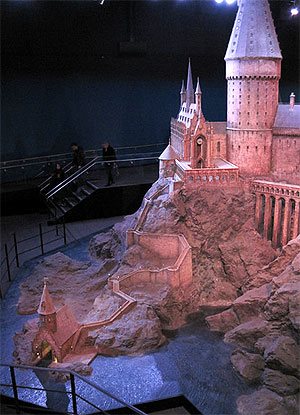
Photo by Red Ryder
To explain: The Hogwarts Castle model had always been considered the crown jewel of the Harry Potter production collection at Warner Bros. Studios Leavesden. Originally built back in 2000 for the first film in this series, "Harry Potter and the Sorcerer's Stone ," it took 86 artists & crew members to construct this 1:24 scale recreation of the Hogwarts School of Witchcraft & Wizardry. And this 50 foot-tall model was then used repeatedly over the course of production on the next five "Potter" movies. (Only for "Deathly Hallows – Part 1 " & "Part 2 " did Warner Bros. finally switch over to a CG version of Hogwarts Castle. And even then the CG version of this massive structure was based on a digital scan of that over-sized model).
Anyway … When Warner Bros. and the Thinkwell Group began toying with the idea of building a Harry Potter production attraction at Leavesden (where all eight installments of this acclaimed film series had been shot over the course of a decade), they knew that they had to make use of this 1:24 scale version of Hogwarts Castle. But creating a space to properly present this massive model in (which — at that time — was being stored at nearby Shepperton Studios) was going to take some doing.
"We knew that we wanted the Hogwarts Castle model to be the culmination of the 'Making of Harry Potter' experience. So we purposefully built this room with a ramp that would come in high, give you this amazing dramatic vista of the castle model and then ramp through that space down to the bottom," Hanna explained. "And because it had been chopped into little bits to store at Shepperton, they then had to bring the Hogwarts Castle model in in pieces. And because one wall of this building had been deliberately left open during the 32 days it took to load in & reassemble this massive model, a fox moved in."
And how exactly did Craig know that a full-sized fox had moved into this 1:24 scale version of Hogwarts Castle? "We had fox prints all over the model," Hanna laughed. "We were also doing some time lapse photography at this same time to capture the reassembling of this massive model. So someone went through the footage and stepped through it, frame by frame, knowing that they'd eventually find the culprit."
And how then did the "Making of Harry Potter" construction team deal with their fox problem? "Warner Bros. brought in an animal control guy who put some frankfurters in the model and he eventually captured the booger," Craig continued.
This animal control guy then took the fox away from Warner Bros. Studios Leavesden and released the animal in the Hertfordshire countryside. The only problem was that this animal control officer wasn't taking this creature far enough away. Because — as Hanna explained " … the fox kept coming back. So the joke around the construction site was that this guy was getting 100 quid per fox. Anyway, once we sealed the building, no more foxes."
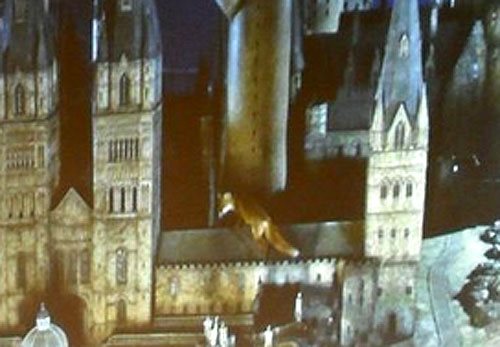
An image of the fox climbing on the Hogwarts Castle model from the time lapse
photography that was done during the construction of this exhibit for the
Warner Bros. Studio Tour London — The Making of Harry Potter attraction.
Copyright 2013 Thinkwell Group, Inc. All rights reserved
So when this fox-free attraction officially opened for business in March of 2012, what did the first visitors to Warner Bros. Studio Tour London – The Making of Harry Potter discover? Something that was deliberately different from what Universal Creative had built in Orlando as part of The Wizarding World of Harry Potter at Islands of Adventure.
"Warners Bros said — right from the beginning as we were developing this attraction — that we're not going magically into the movies. Here at Leavesden, we're going to talk about the magic of the movies. And that was always the clear differentiator between what we were doing and what Universal Creative was developing for Orlando," Craig said. "Which — I have to admit — did initially cause some frustration for the team at Thinkwell. They say things like 'Wouldn't it be great if we got to see Moaning Myrtle talking in a painting?' And I'd then have to ask the team 'Was that how it was done on the set? Because if it wasn't, we can't do that. We're not making magic. We're making movie magic.' And that became the filter for everything."
During the two years that Thinkwell worked with Warner Bros. on the design of the "Making of Harry Potter," that was the central idea that Hanna and his team kept circling back on. That whatever was going to be put on display here at this 150,000 square-foot attraction had to be authentic to what was done during the production of the Harry Potter films. Which was very different from what Universal Creative was doing for its theme parks. Where the driving idea was that you're living the movies."
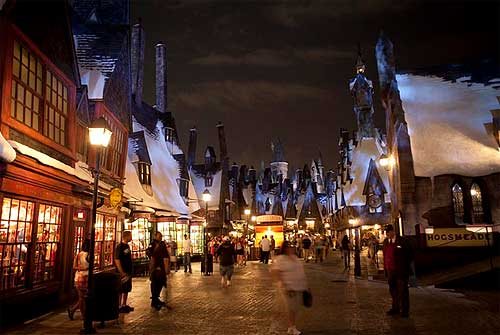
Hogsmeade Village at night at The Wizarding World of Harry Potter at
Universal's Islands of Adventure. Copyright Universal Orlando.
All rights reserved
"Interestingly enough, we didn't know what Universal was up with their Harry Potter project. Luckily the two experiences wound up being very complimentary. Theirs is such a fanciful experience. It's what every Harry Potter fan wishes they could do in the real world. Walk into Hogsmeade Village as a magical person, get a wand and drink Butterbeer, do all those things," Craig said. "But the real fans of the Potter films also want to see the authentic items that were used in the production of these movies. Which is why I'm constantly reading online about people who have visited both attractions and love them equally. They go to London and then Orlando or visa versa."
And when I say authentic, I mean authentic. As part of his TEA Case Studies Day talk, Hanna fondly looked back on the very first time that he got to walk the sets of a Harry Potter movie at Leavesden Studio.
"This was back in 2007. I think the fourth film was in production at that time. And I remember thinking that you could just open this whole thing up to the public. Because everything that was being done for the Potter films was being done to an extraordinary level of detail," Craig recalled. "We saw these absolutely amazing sets. We then went over to the art department & the creature shop, all of which was located right there onsite at Leavesden Studios and saw those beautiful sculpts and creatures being created. Wherever we turned, our jaws were just hitting the floor."
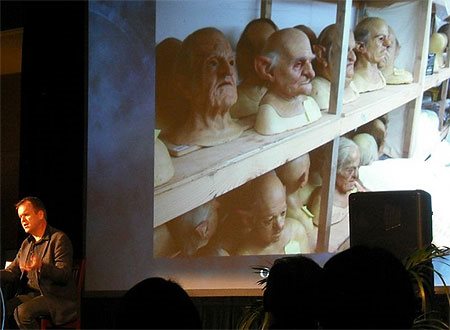
Craig Hanna (L) shows THEA members some of the photographs that
he took behind-the-scenes at Leavesden Studio as he and the team
from Thinkwell were touring this facility as thy developed their
"Making of Harry Potter" attraction.
Photo by Shelly Valladolid
But what genuinely excited Hanna about the potential of building a 'Making of Harry Potter' exhibit right there onsite at Leavesden Studios was the already-created assets that he and his team would then be able to build this attraction around.
"You have to understand that — after Warner Bros. acquired the movie rights for the Harry Potter books in 1998 and then settled on Leavesden Studios as the place in the UK where they then wanted to shoot these movies — the executives at Warner Bros. did this very smart thing. They told the Potter production team that 'We don't know what's coming up in the upcoming books from J.K. Rowling. So you'd better save everything so that we can then save some money if we need to reuse that set, prop or costume again in another movie further on down the road,' " Craig explained. "So there were hundreds of these Harry Potter-related shipping containers onsite at Leavesden Studios. And every one we opened up was a treasure trove."
Which — in a weird sort of way — having so much authentic Harry Potter movie material to chose from actually made things harder for the folks from Thinkwell.
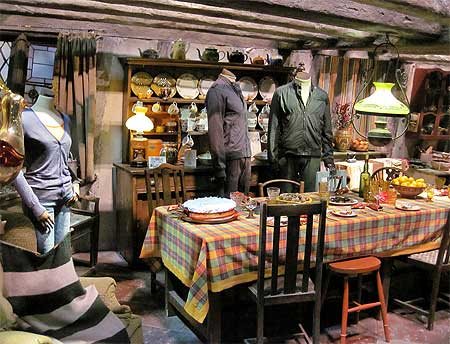
The portion of the Weasley Burrow that Craig Hanna was able to convince
Warner Bros. official to include in their "Making of Harry Potter" attraction.
Photo by Red Ryder
"It's amazing how many beautiful, extraordinary things we agonized over. I mean, you can pick through the Potter films yourself and then think about what props & sets that you'd like to see on display in an exhibit like this," Hanna said. "Me personally, I wanted put the entire Weasley Burrow in there so badly. I wanted to do a walk-thru of this whole set from the films so that everyone could then see how wonky everything was in the Weasley household. But I only got to put in a tiny piece of that set."
"I also wanted to include the Shell Cottage from 'Deathly Hallows,' which was this amazing set that was made entirely out of these gorgeous real sea shells," Craig continued. "But it was Potter executive producer David Heyman who actually talked us out of doing that. Arguing that — since the Shell Cottage was really only going to be onscreen for 30 seconds or so in 'Deathly Hallows' — we shouldn't make that set, as pretty as it might be, part of the display. That we should go more for the more iconic settings. The places that fans of the Harry Potter film series would genuinely love to visit."
Which — obviously — included the Great Hall at Hogwarts Castle. Back in 2000, this was one of the very first sets built for the Harry Potter film series. And since production designer Stuart Craig knew that the filmmakers would be shooting scenes in this 120 feet long by 40 feet wide space for the next 10 years, he had the floor of this set made out of genuine York Stone.
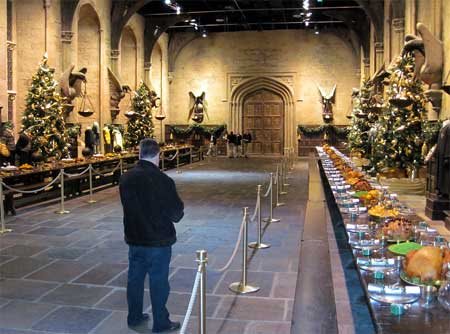
The Great Hall set reassembled onsite at Warner Bros. Studio London
– The Making of Harry Potter attraction. Photo by Red Ryder
"And when it came time to transfer the Great Hall set over to its original soundstage at Leavesden to the 'Making of Harry Potter' attraction … Well, we numbered each of those York Stones and then carefully noted where it was located on the floor on the Great Hall set. And then those stones were placed in the exact same spot on the floor of the Great Hall display that we were creating for the attraction. That's an example of how obsessive we were when it came to getting the detail just right for this 'Making of Harry Potter' exhibit," Craig enthused.
Of course, what helped with getting all of the details right for Warner Bros. Studio Tour London – The Making of Harry Potter was that — when the crew from Thinkwell were temporarily stumped by something — all Hanna & his crew had to do was hike across the Leavesden lot. Where they could then consult with the artists & technicians who's actually been on set and/or behind the camera when these various Potter movies were being shot.
"The Heads of Departments at Leavesden have helped with every aspect of the 'Making of Harry Potter' attraction and they continue to help us with the attraction. It's a real tribute to their artistry & dedication that this display is as authentic as it is," Craig continued.
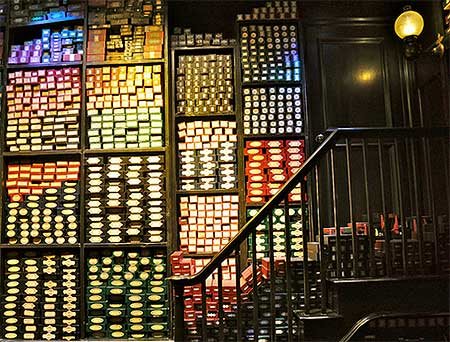
Some of the 3000 wand boxes on display in the Warner Bros. Studio Tour –
The Making of Harry Potter attraction's version of Olivander's. Copyright
2011 Warner Bros. Entertainment Inc. Harry Potter Publishing
Rights copyright JKR.
And to pay tribute to those Heads of Departments — not to mention the 3000 other people who worked on all 8 of the "Harry Potter" films over the past ten years … Well, that's why the folks at Thinkwell decided to turn the final scene of this attraction into a very special version of Ollivander's wand shop.
"There are over 3000 wand boxes on display in our version of Ollivander's. And on the label of each of these boxes is the name of someone who worked on the Harry Potter movies," Hanna explained. "Now we thought that people would just stroll through this space. But — as it turns out — so many people in the UK had friends or family who worked on these films that they then linger in Ollivander's, looking for the wand box with their friend or family members name on it. Which is why we've now got an actor stationed in this part of the exhibit who's memorized where a lot of the wand boxes are located. And he then helps visitors find the wand boxes that they're looking for."
And speaking of visitors … Warner Bros. Studio Tour London – The Making of Harry Potter certainly has become a hit with visitors to the UK. Even though there are no walk-up tickets sold to this attraction (all visits to the Leavesden lot have to be pre-booked in advance), the Warner Bros. Studio Tour London still managed to welcome its one millionth visitor within nine months of its March 2012 opening.
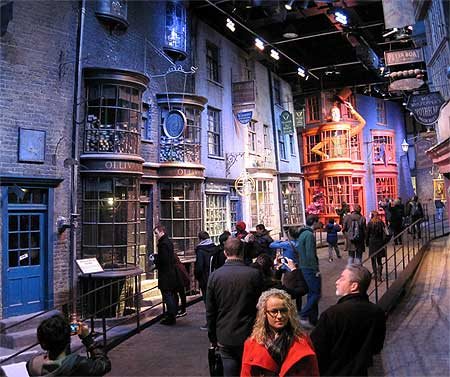
Visitors to the Warner Bros. Studio Tour London – The Making of Harry
Potter attraction gaze up at the Diagon Alley sets. Photo by Red Ryder
What's more, people who have visited this 150,000 square foot display just been raving about the overall experience. How — thanks to the way people are plussed through the attraction (i.e. Every half hour, a new group of 125 people are allowed to enter the "Making of Harry Potter." And only 5000 tickets total are sold each day) — you never feel rushed or crowded. Throughout most of the Warner Bros. Studio Tour London (with the possible exception of the Great Hall. Which — because this space served as the opening scene / introduction to the attraction — guests have just a half an hour to explore the displays located here) you can linger as long as you want at any of the exhibits and displays.
In fact, there's such good buzz these days about Warner Bros. Studio Tour London – The Making of Harry Potter that word got back to Buckingham Palace. Which is why — just last week — Their Royal Highnesses The Duke and Duchess of Cambridge and Prince Harry made a special trip out to Leavesden just so they could spend some time exploring Diagon Alley (or at least the sets that were used when the "Potter" filmmakers were shooting scenes set in & around Diagon Alley) as well as trying their hands at wielding a wand.
So does it please Hanna that the project that he and his team at Thinkwell worked on for 5 years has been so enthusiastically embraced by the royals & Harry Potter fans alike?
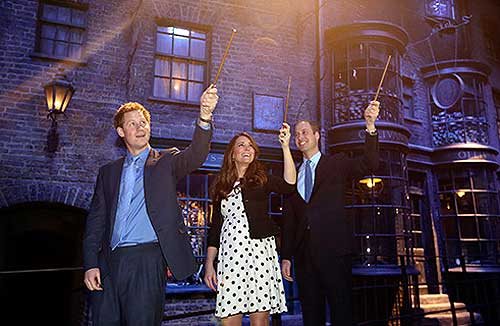
Prince Harry and the Duke & Duchess of Cambridge try and cast a spell in Diagon
Alley which will make the sign above Potage's Cauldron Shop bang and flash as
if by magic. Copyright 2011 Warner Bros. Entertainment Inc. Harry Potter
Publishing Rights copyright JKR.
"I'm just glad that I got the chance to work on this little-known IP and help bring it to everyone's attention," Craig said in conclusion, his tongue firmly planted in his cheek.
Special thanks to the Themed Entertaiment Association for allowing JHM to attend this year's Case Studies Day. More importantly, thanks to Noe & Shelly Valladolid for making a special trip out to the Disneyland Resort last month to cover this day-long event for the site.
Theme Parks & Themed Entertainment
Disney and Macy’s 90-Year Thanksgiving Day Parade Partnership: From Mickey’s First Balloon to Minnie’s Big Debut

Now, folks, if you’re like me, Thanksgiving just wouldn’t be the same without a coffee, a cozy seat, and Macy’s Thanksgiving Day Parade on the TV. And if you’re really like me, you’re watching for one thing: Disney balloons floating down 34th Street. Ever wondered how Mickey, Donald, and soon Minnie Mouse found their way into this beloved New York tradition? Well, grab your popcorn because we’re diving into nearly 90 years of Disney’s partnership with Macy’s.
The Very First Parade and the Early Days of Balloons
The Macy’s Thanksgiving Day Parade goes way back to 1924, but if you can believe it, balloons weren’t part of the festivities until 1927. That first lineup included Felix the Cat, a dragon, and a toy soldier, all towering above the crowds. Back then, Macy’s had a pretty wild idea to end the parade: they would let the balloons drift off into the sky, free as birds. But this wasn’t just Macy’s feeling generous. Each balloon had a message attached, offering a $100 reward (about $1,800 in today’s dollars) for anyone who returned it to the flagship store on 34th Street.
And here’s where it gets interesting. This tradition carried on for a few years, right up until 1932, when Felix the Cat almost took down a plane flying over New York City! Imagine that—you’re flying into LaGuardia, and suddenly, there’s a 60-foot balloon drifting toward your wing. Needless to say, that was the end of Macy’s “fly away” stunt, and from then on, the balloons have stayed firmly grounded after the parade ends.

1934: Mickey Mouse Floats In, and Disney Joins the Parade
It was 1934 when Mickey Mouse finally made his grand debut in the Macy’s parade. Rumor has it Walt Disney himself collaborated with Macy’s on the design, and by today’s standards, that first Mickey balloon was a bit of a rough cut. This early Mickey had a hotdog-shaped body, and those oversized ears gave him a slightly lopsided look. But no one seemed to mind. Mickey was there, larger than life, floating down the streets of New York, and the crowd loved him.
Mickey wasn’t alone that year. He was joined by Pluto, Horace Horsecollar, and even the Big Bad Wolf and Practical Pig from The Three Little Pigs, making it a full Disney lineup for the first time. Back then, Disney wasn’t yet the entertainment powerhouse we know today, so for Walt, getting these characters in the parade meant making a deal. Macy’s required its star logo to be featured on each Disney balloon—a small concession that set the stage for Disney’s long-standing presence in the parade.
Duck Joins and Towers Over Mickey
A year later, in 1935, Macy’s introduced Donald Duck to the lineup, and here’s where things got interesting. Mickey may have been the first Disney character to float through the parade, but Donald made a huge splash—literally. His balloon was an enormous 60 feet tall and 65 feet long, towering over Mickey’s 40-foot frame. Donald quickly became a fan favorite, appearing in the lineup for several years before being retired.
Fast-forward a few decades, and Donald was back for a special appearance in 1984 to celebrate his 50th birthday. Macy’s dug the balloon out of storage, re-inflated it, and sent Donald down 34th Street once again, bringing a bit of nostalgia to the holiday crowd.
A Somber Parade in 2001
Now, one of my most memorable trips to the parade was in 2001, just weeks after the 9/11 attacks. Nancy and I, along with our friends, headed down to New York, and the mood was something I’ll never forget. We watched the start of the parade from Central Park West, but before that, we went to the Museum of Natural History the night before to see the balloons being inflated. They were covered in massive cargo nets, with sandbags holding them down. It’s surreal to see these enormous balloons anchored down before they’re set free.
That year, security was intense, with police lining the streets, and then-Mayor Rudy Giuliani rode on the Big Apple float to roaring applause. People cheered his name, waving and shouting as he passed. It felt like the entire city had turned out to show their resilience. Even amidst all the heightened security and tension, seeing those balloons—brought a bit of joy back to the city.

Balloon Prep: From New Jersey’s MetLife Stadium to California’s D23 Expo
Each year before the parade, Macy’s holds a rehearsal event known as Balloon Fest at MetLife Stadium in New Jersey. This is where handlers get their first crack at guiding the balloons, practicing with their parade masters, and learning the ropes—literally. It’s an entire production unto itself, with dozens of people rehearsing to make sure these enormous inflatables glide smoothly down the streets of New York on parade day.
In 2015, Macy’s took the balloon show on the road, bringing their Buzz Lightyear balloon out to California for the D23 Expo. I was lucky enough to be there, and watching Buzz get inflated piece by piece in the Anaheim Convention Center parking lot was something to behold. Each section was filled with helium in stages, and when they got around to Buzz’s lower half, well, there were more than a few gas-related jokes from the crowd.
These balloons seem to have a personality all their own, and seeing one like Buzz come to life up close—even outside of New York—had all the excitement and anticipation of the real deal.

Mickey’s Comeback as a Bandleader and Sailor Mickey
After a long hiatus, Mickey Mouse made his return to the Macy’s parade in 2000, this time sporting a new bandleader outfit. Nine years later, in 2009, Sailor Mickey joined the lineup, promoting Disney Cruise Line with a nautical twist. Over the past two decades, Disney has continued to enchant parade-goers with characters like Buzz Lightyear in 2008 and Olaf from Frozen in 2017. These balloons keep Disney’s iconic characters front and center, drawing in both longtime fans and new viewers.
But ever wonder what happens to the balloons after they reach the end of 34th Street? They don’t just disappear. Each balloon is carefully deflated, rolled up like a massive piece of laundry, and packed into storage bins. From there, they’re carted back through the Lincoln Tunnel to Macy’s Parade Studio in New Jersey, where they await their next flight.

Macy’s Disney Celebration at Hollywood Studios
In 1992, Macy’s took the spirit of the parade down to Disney-MGM Studios in Orlando. After that year’s parade, several balloons—including Santa Goofy, Kermit the Frog, and Betty Boop—were transported to Hollywood Studios, re-inflated, and anchored along New York Street as part of a holiday display. Visitors could walk through this “Macy’s New York Christmas” setup and see the balloons up close, right in the middle of the park. While this display only ran for one season, it paved the way for the Osborne Family Spectacle of Dancing Lights, which became a holiday staple at the park for years to come.

Minnie Mouse’s Long-Awaited Debut in 2024
This year, Minnie Mouse will finally join the parade, making her long-overdue debut. Macy’s is rolling out the red carpet for Minnie’s arrival with special pop-up shops across the country, where fans can find exclusive Minnie ears, blown-glass ornaments, T-shirts, and more to celebrate her first appearance in the Thanksgiving Day Parade.

For those lucky enough to catch the parade this year, you’ll see Minnie take her first float down 34th Street, decked out in her iconic red bow and polka-dot dress. Macy’s and Disney are also unveiling a new Disney Cruise Line float honoring all eight ships, including the latest, the Disney Treasure.
As always, I’ll be watching from my favorite chair, coffee in hand, as Minnie makes her grand entrance. The 98th annual Macy’s Thanksgiving Day Parade airs live on NBC, and it’s a tradition you won’t want to miss—whether you’re on 34th Street or tuning in from home.
Theme Parks & Themed Entertainment
Disney’s Forgotten Halloween Event: The Original Little Monsters on Main Street

When most Disney fans think of Halloween in the parks, they immediately picture Mickey’s Not-So-Scary Halloween Party at Walt Disney World or the Oogie Boogie Bash at Disneyland Resort. But before those events took over as the must-attend spooky celebrations, there was a little-known event at Disneyland called Little Monsters on Main Street. And its origins? Well, they go all the way back to the 1980s, during a time when America was gripped by fear—the Satanic Panic.

You see, back in the mid-1980s, parents were terrified that Halloween had become dangerous. Urban legends about drug-laced candy or razor blades hidden in apples were widespread, and many parents felt they couldn’t let their kids out of sight for even a moment. Halloween, which was once a carefree evening of trick-or-treating in the neighborhood, had suddenly become a night filled with anxiety.
This is where Disneyland’s Little Monsters on Main Street came in.

The Origins of Little Monsters on Main Street
Back in 1989, the Disneyland Community Action Team—later known as the VoluntEARS—decided to create a safe, nostalgic Halloween experience for Cast Members and their families. Many schools in the Anaheim area were struggling to provide basic school supplies to students, and the VoluntEARS saw an opportunity to combine a safe Halloween with a charitable cause. Thus, Little Monsters on Main Street was born.
This event was not open to the general public. Only Disneyland Cast Members could purchase tickets, which were initially priced at just $5 each. Cast Members could bring their kids—but only as many as were listed as dependents with HR. And even then, the park put a cap on attendance: the first event was limited to just 1,000 children.

A Unique Halloween Experience
Little Monsters on Main Street wasn’t just another Halloween party. It was designed to give kids a safe, fun environment to enjoy trick-or-treating, much like the good old days. On Halloween night in 1989, kids in costume wandered through Disneyland with their pillowcases, visiting 20 different trick-or-treat stations. They also had the chance to ride a few of their favorite Fantasyland attractions, all after the park had closed to the general public.
The event was run entirely by the VoluntEARS—about 200 of them—who built and set up all the trick-or-treat stations themselves. They arrived at Disneyland before the park closed and, as soon as the last guest exited, they began setting up stations across Main Street, Adventureland, Frontierland, Fantasyland, and Tomorrowland. The event ran from 7:30 to 9:30 p.m., and by the time the last pillowcase-wielding kid left, the VoluntEARS cleaned everything up, making sure the park was ready for the next day’s operations.
It wasn’t just candy and rides, though. The event featured unique entertainment, like a Masquerade Parade down Main Street, U.S.A., where kids could show off their costumes. And get this—Disneyland even rigged up a Cast Member dressed as a witch to fly from the top of the Matterhorn to Frontierland on the same wire that Tinker Bell uses during the fireworks. Talk about a magical Halloween experience!
The Haunted Mansion “Tip-Toe” Tour
Perhaps one of the most memorable parts of Little Monsters on Main Street was the special “tip-toe tour” of the Haunted Mansion. Now, Disneyland’s Haunted Mansion can be a pretty scary attraction for younger kids, so during this event, Disney left the doors to the Stretching Room and Portrait Gallery wide open. This allowed kids to walk through and peek at the Haunted Mansion’s spooky interiors without actually having to board the Doom Buggies. For those brave enough to ride, they could, of course, take the full trip through the Haunted Mansion—or they could take the “chicken exit” and leave, no harm done.

Growing Success and a Bigger Event
Thanks to the event’s early success, Little Monsters on Main Street grew in size. By 1991, the attendance cap had been raised to 2,000 kids, and Disneyland added more activities like magic shows and hayrides. They also extended the event’s hours, allowing kids to enjoy the festivities until 10:30 p.m.
In 2002, the event moved over to Disney California Adventure, where it could accommodate even more kids—up to 5,000 in its later years. The name was also shortened to just Little Monsters, since it was no longer held on Main Street. This safe, family-friendly Halloween event continued for several more years, with the last mention of Little Monsters appearing in the Disneyland employee newsletter in 2008. Though some Cast Members recall the event continuing until 2012, it eventually made way for Disney’s more public-facing Halloween events.

From Little Monsters to Mickey’s Not-So-Scary and Oogie Boogie Bash
Starting in the early 2000s, Disney began realizing the potential of Halloween-themed after-hours events for the general public. These early versions of Mickey’s Halloween Party and Mickey’s Halloween Treat eventually evolved into today’s Mickey’s Not-So-Scary Halloween Party and Oogie Boogie Bash. Unfortunately, this also marked the end of the intimate, Cast Member-exclusive Little Monsters event, but it paved the way for the large-scale Halloween celebrations we know and love today.
While it’s bittersweet to see Little Monsters on Main Street fade into Disney history, its legacy lives on through these modern Halloween parties. And even though Cast Members now receive discounted tickets to Mickey’s Not-So-Scary and Oogie Boogie Bash, the special charm of an event created specifically for Disney’s employees and their families remains something worth remembering.
The Merch: A Piece of Little Monsters History
For Disney collectors, the exclusive merchandise created for Little Monsters on Main Street is still out there. You can find pins, name tags, and themed pillowcases on sites like eBay. One of the coolest collectibles is a 1997 cloisonné pin set featuring Huey, Dewey, and Louie dressed as characters from Hercules. Other sets paid tribute to the Main Street Electrical Parade and Pocahontas, while the pillowcases were uniquely designed for each year of the event.

While Little Monsters on Main Street may be gone, it’s a fascinating piece of Disneyland history that played a huge role in shaping the Halloween celebrations we enjoy at Disney parks today.
Want to hear more behind-the-scenes stories like this? Be sure to check out I Want That Too, where Lauren and I dive deep into the history behind Disney’s most beloved attractions, events, and of course, merchandise!
Theme Parks & Themed Entertainment
The Story of Mickey’s Not-So-Scary Halloween Party: From One Night to a Halloween Family Tradition

The spooky season is already in full swing at Disney parks on both coasts. On August 9th, the first of 38 Mickey’s Not-So-Scary Halloween Party (MNSSHP) nights for 2024 kicked off at Florida’s Magic Kingdom. Meanwhile, over at Disney California Adventure, the Oogie Boogie Bash began on August 23rd and is completely sold out across its 27 dates this year.
Looking back, it’s incredible to think about how these Halloween-themed events have grown. But for Disney, the idea of charging guests for Halloween fun wasn’t always a given. In fact, when the very first Mickey’s Not-So-Scary Halloween Party debuted on October 31, 1995, it was a modest one-night-only affair. Compare that to the near month-long festivities we see today, and it’s clear that Disney’s approach to Halloween has evolved considerably.
A Not-So-Scary Beginning
I was fortunate enough to attend that very first MNSSHP back in 1995, along with my then 18-month-old daughter Alice and her mom, Michelle. Tickets were a mere $16.95 (I know, can you imagine?), and we pushed Alice around in her sturdy Emmaljunga stroller—Swedish-built and about the size of a small car. Cast Members, charmed by her cuteness, absolutely loaded us up with candy. By the end of the night, we had about 30 pounds of fun-sized candy bars, making that push up to the monorail a bit more challenging.

This Halloween event was Disney’s response to the growing popularity of Universal Studios Florida’s own Halloween hard ticket event, which started in 1991 as “Fright Nights” before being rebranded as “Halloween Horror Nights” the following year. Universal’s gamble on a horror-themed experience helped salvage what had been a shaky opening for their park, and by 1993, Halloween Horror Nights was a seven-night event, with ticket prices climbing as high as $35. Universal had stumbled upon a goldmine, and Disney took notice.
A Different Approach
Now, here’s where Disney’s unique strategy comes into play. While Universal embraced the gory, scare-filled world of horror, Disney knew that wasn’t their brand. Instead of competing directly with blood and jump-scares, Disney leaned into what they did best: creating magical, family-friendly experiences.
Thus, Mickey’s Not-So-Scary Halloween Party was born. The focus was on fun and whimsy, not fear. Families could bring their small children without worrying about them being terrified by a chainsaw-wielding maniac around the next corner. This event wasn’t just a Halloween party—it was an extension of the Disney magic that guests had come to expect from the parks.
Disney had some experience with seasonal after-hours events, most notably Mickey’s Very Merry Christmas Party, which had started in 1983. But the Halloween party was different, as the Magic Kingdom wasn’t yet decked out in Halloween decor the way it is today. Disney had to create a spooky (but not too spooky) atmosphere using temporary props, fog machines, and, of course, lots of candy.
A key addition to that first event? The debut of the Headless Horseman, who made his eerie appearance in Liberty Square, riding a massive black Percheron. It wasn’t as elaborate as the Boo-to-You Parade we see today, but it marked the beginning of a beloved Disney Halloween tradition.
A Modest Start but a Big Future
That first MNSSHP in 1995 was seen as a trial run. As Disney World spokesman Greg Albrecht told the Orlando Sentinel, “If it’s successful, we’ll do it again.” And while attendance was sparse that night, there was clearly potential. By 1997, the event expanded to two nights, and by 1999, Mickey’s Not-So-Scary Halloween Party had grown into a multi-night celebration with a full-fledged parade. Today, in 2024, it’s a staple of the fall season at Walt Disney World, offering 38 nights of trick-or-treating, character meet-and-greets, and special entertainment.
Universal’s Influence

It’s interesting to reflect on how Disney’s Halloween event might never have existed without the competition from Universal. Just as “The Wizarding World of Harry Potter” forced Disney to step up their game with “Star Wars: Galaxy’s Edge,” Universal’s success with Halloween Horror Nights likely spurred Disney into action with MNSSHP. The friendly rivalry between the two parks has continually pushed both to offer more to their guests, and we’re all better off because of it.
So the next time you find yourself trick-or-treating through the Magic Kingdom, watching the Headless Horseman gallop by, or marveling at the seasonal fireworks, take a moment to appreciate how this delightful tradition came to be—all thanks to a little competition and Disney’s commitment to creating not-so-scary magic.
For more Disney history and behind-the-scenes stories, check out the latest episodes of the I Want That Too podcast on the Jim Hill Media network.
-

 History10 months ago
History10 months agoThe Evolution and History of Mickey’s ToonTown
-

 History11 months ago
History11 months agoUnpacking the History of the Pixar Place Hotel
-

 History11 months ago
History11 months agoFrom Birthday Wishes to Toontown Dreams: How Toontown Came to Be
-

 Film & Movies8 months ago
Film & Movies8 months agoHow Disney’s “Bambi” led to the creation of Smokey Bear
-

 News & Press Releases10 months ago
News & Press Releases10 months agoNew Updates and Exclusive Content from Jim Hill Media: Disney, Universal, and More
-

 Merchandise8 months ago
Merchandise8 months agoIntroducing “I Want That Too” – The Ultimate Disney Merchandise Podcast
-

 Theme Parks & Themed Entertainment3 months ago
Theme Parks & Themed Entertainment3 months agoDisney’s Forgotten Halloween Event: The Original Little Monsters on Main Street
-

 Film & Movies3 months ago
Film & Movies3 months agoHow “An American Tail” Led to Disney’s “Hocus Pocus”








